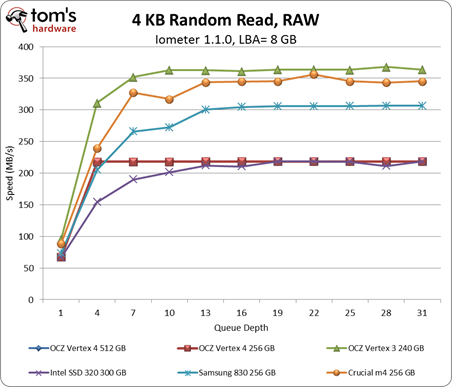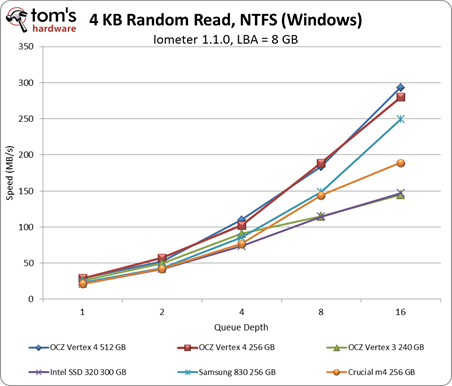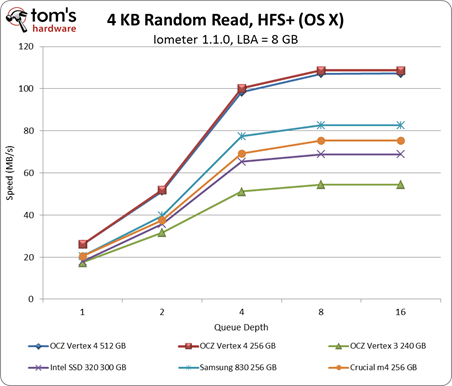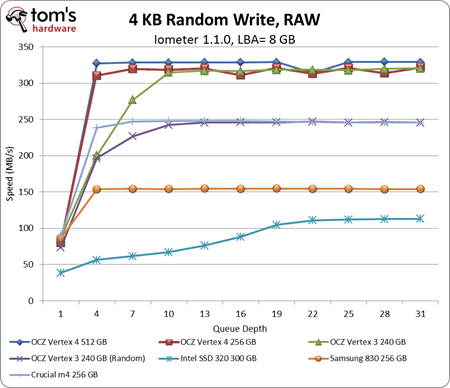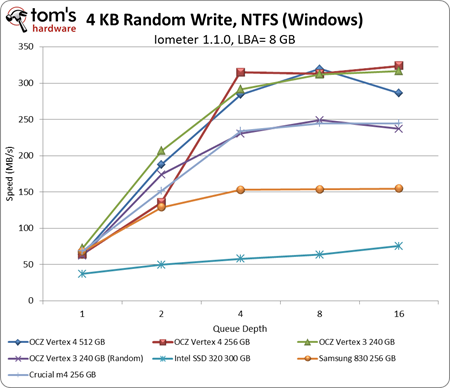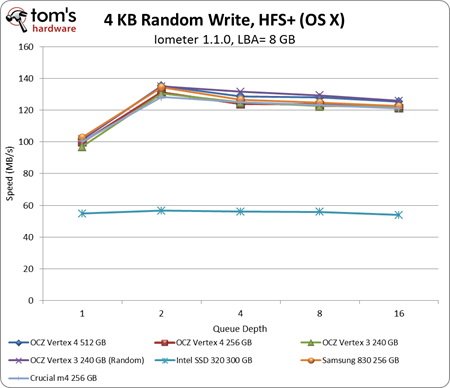OCZ Vertex 4 Review: A Flagship SSD Powered By...Indilinx?
4 KB Random Performance: RAW, Windows, And Mac
Random Read Performance (background info)
Examples include antivirus scans and typing in Word
We're used to seeing SSDs built on second-generation SandForce controllers (like the Vertex 3) perform at the head of the pack. By comparison, the Vertex 4 falls behind. Using an 8 GB LBA span, the 256 GB and 512 GB models hover just above the 200 MB/s barrier. It's a bit difficult to see from the graph, but both Vertex 4s offer nearly identical performance. The Vertex 3 still maintains a clear lead, as it's the only SSD capable of punching through the 400 MB/s ceiling at a queue depth of seven.
Once we format our test drives, we see that the performance overhead imposed by a file system is quite considerable. Based on past reviews, we know that physical drive performance should start out at roughly 80-90 MB/s for the 256 GB m4, 256 GB 830, Vertex 3s, and SSD 520s—but that's not what we see here. Formatted, all the tested SSDs start at roughly 20 MB/s.
However, the Vertex 4 does seem to enjoy a slight (10 MB/s) advantage at queue depths higher than four. That gap quickly expands to 70 MB/s after moving up to eight outstanding I/O operations.
Our Windows 7-based system returns relatively strong random read results. At a queue depth of eight, every SSD punches through the 100 MB/s barrier.
This does not hold true on our MacBook Pro, which is limited to sub-100 MB/s speeds. Nevertheless, OCZ's newest SSD slightly leads its competition (by 6 MB/s) at low queue depths. Once you scale up to queue depth of eight, you see the Vertex 4 enjoying a 20 MB/s speed advantage in random reads.
Get Tom's Hardware's best news and in-depth reviews, straight to your inbox.
Random Write Performance
Examples include email, file compression, and Web browsing
The unique nature of SandForce's compression technology requires breaking random write analysis into two parts. Presented with highly compressible data (the sort of information typically handled elegantly by the SandForce-based drives), OCZ's Vertex 4 wrestles away a victory. Particularly at low queue depths, the new Vertex dominates its predecessor.
Incompressible data (denoted by OCZ Vertex 3 240 GB [Random] in the chart above) is the Vertex 3's Achilles' heel, preventing it from exceeding random write speeds above 250 MB/s. The Everest 2 controller does not use this compression-dependent technology, so the Vertex 4 doesn't miss a beat.
Our formatted Mac and PC yield vastly different results. As we saw in the read tests above, the Windows 7-based PC seems much better suited to delivering solid random write performance, and the outcome largely mirrors what we see when we test at the physical block level.
In contrast, the results from our MacBook Pro reflect significantly less performance. Complicating analysis is a very tight grouping. As you can see, OCZ's Vertex 4, Vertex 3, and Samsung's 830 are all pretty similar. The only outlier is Intel's SSD 320, the only SATA 3Gb/s SSD in our charts.
Current page: 4 KB Random Performance: RAW, Windows, And Mac
Prev Page Test Setup And Benchmarks Next Page 128 KB Sequential Performance: RAW, Windows, And Mac-
compton Octane was not a special and unique snowflake; Indeed, someone else's fingerprints were all over it. Vertex4 is certainly unique, but I fully expect the next round of drive launches using Marvell products to look like the V4, but possibly with some more balance.Reply -
billybobser Seems to good to be true.Reply
We'll see how they are once they've been out in the open for 6 months when problems will/will not flare up. -
maxinexus As Billy said only time will tell. These preliminary tests are great and pricing is better but still SSD are expensive...we need to get to cents not dollars per GB. Anyway good start OCZ...now the only thing you need is your own NANDs...perhaps in few yearsReply -
jgutz2006 This is a great step and makes financial sense for OCZ to come to market with a competitive product and possibly undercut all the others. Its a no brainer im my world. Force Samsung to sell units with less profit marginsReply -
Branden it'll be interesting to see how reliable these drives are and what their failure rate is going to be. OCZ's vertex 2 and 3 drives were horribly unreliable - in my experience 50% failure/DOA rate, my local shop said they see about 10% of them returned due to failure (and that's just within their 2 week return window alone).Reply
sorry OCZ, you've lost my business this time around. i've since replaced all my remaining OCZ SSD's with crucial m4's, they may not quite perform as well as your latest offerings but in my experience reliability > performance. -
JackNaylorPE When I built Son No.2 's box, we installed the Seagate Barracuda XT on Friday and measured boot times at 21.2 seconds to the Password entry screen. The Vertex 3 arrived on Monday and after installing that, we measured boot times at 15.6 seconds. Not commenting on the actual times as differences in hardware as well as testing parameters could push it in any direction, but what I will comment on is the HD choice for this test.Reply
My testing showed it took 36% extra time to boot off the HD instead of the HD. This test has it taking 226 % longer. If we're gonna test the best SSD's, I'd sure like to see a best in class HD added to the comparisons. -
burnley14 Brandenit'll be interesting to see how reliable these drives are and what their failure rate is going to be. OCZ's vertex 2 and 3 drives were horribly unreliable - in my experience 50% failure/DOA rate, my local shop said they see about 10% of them returned due to failure (and that's just within their 2 week return window alone).sorry OCZ, you've lost my business this time around. i've since replaced all my remaining OCZ SSD's with crucial m4's, they may not quite perform as well as your latest offerings but in my experience reliability > performance.It's interesting because so many people have talked about how unreliable they are, but in my personal experience (a small sample size, granted) I've been very pleased with both the Vertex 2's performance and reliability and the Agility 3's. Maybe I'm just lucky.Reply -
drwho1 all I read was: support for 2TB... *drooling*Reply
Price for 2TB SSD?
*not drooling anymore* -
OntarioHero Hmmm. Basically OCZ decided "Indilinx too slow! sod it, stick 1GB buffer in there!"Reply
